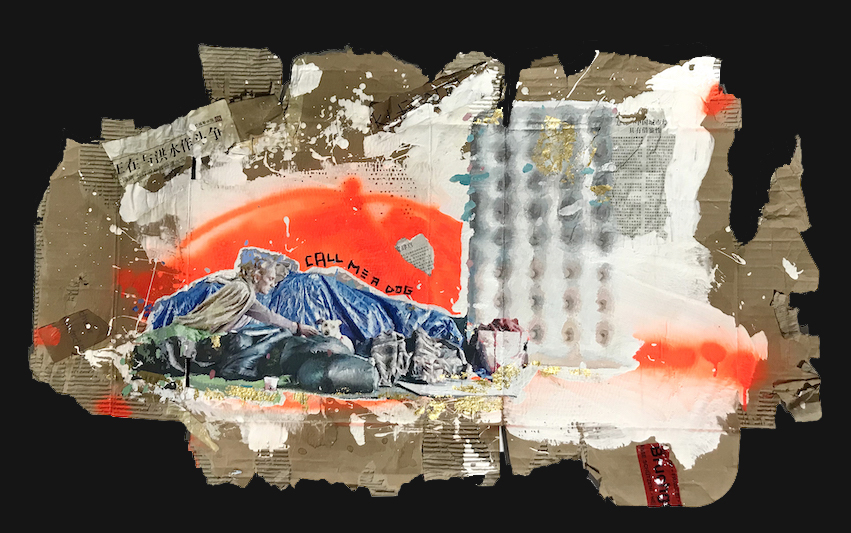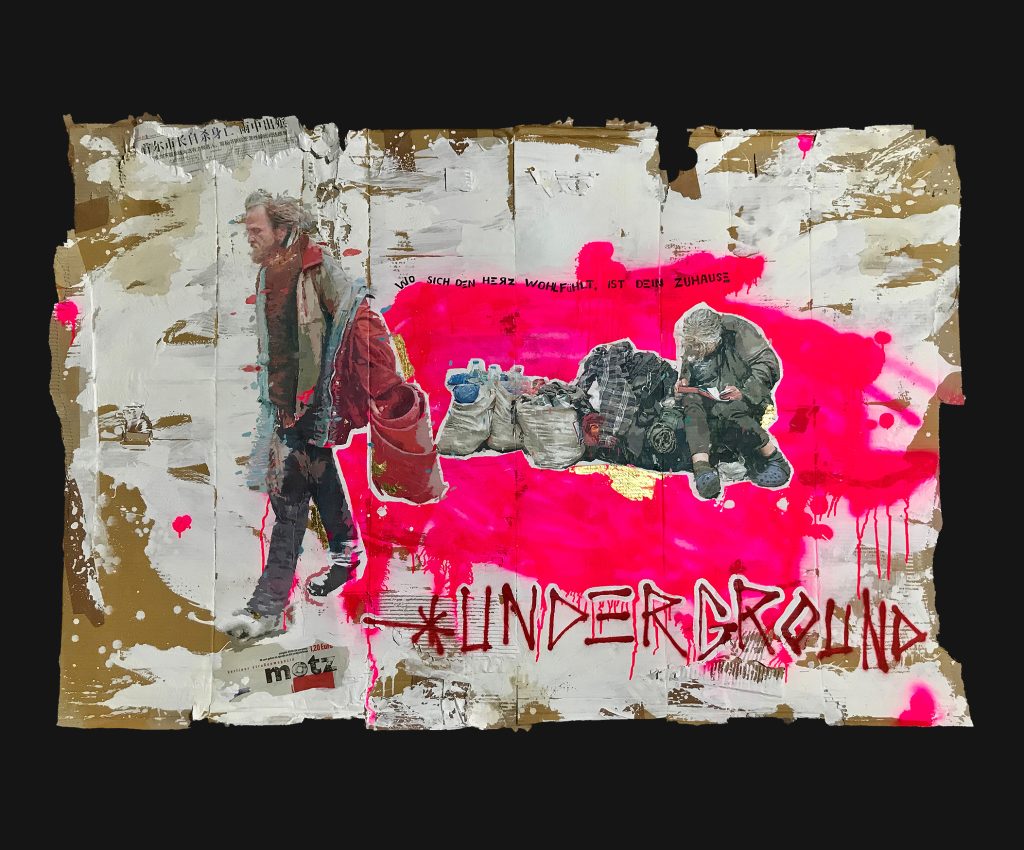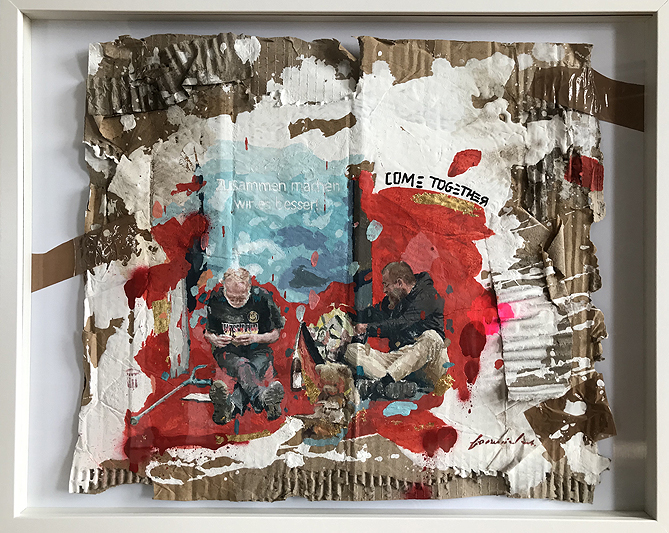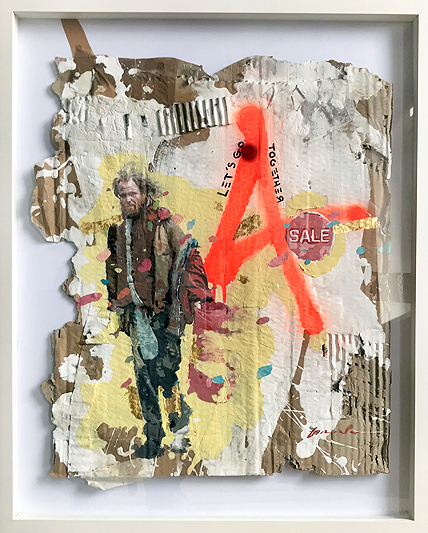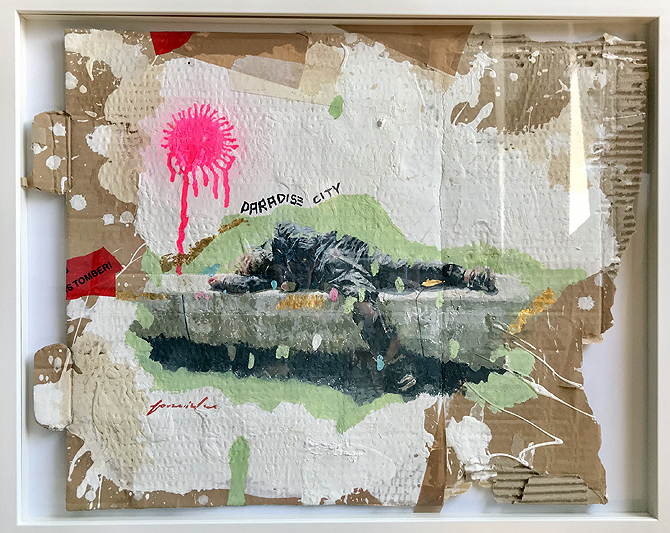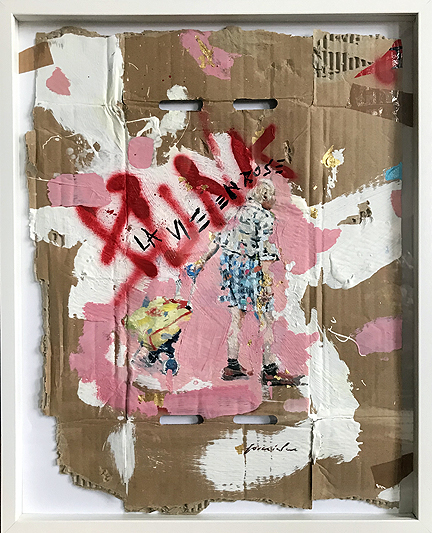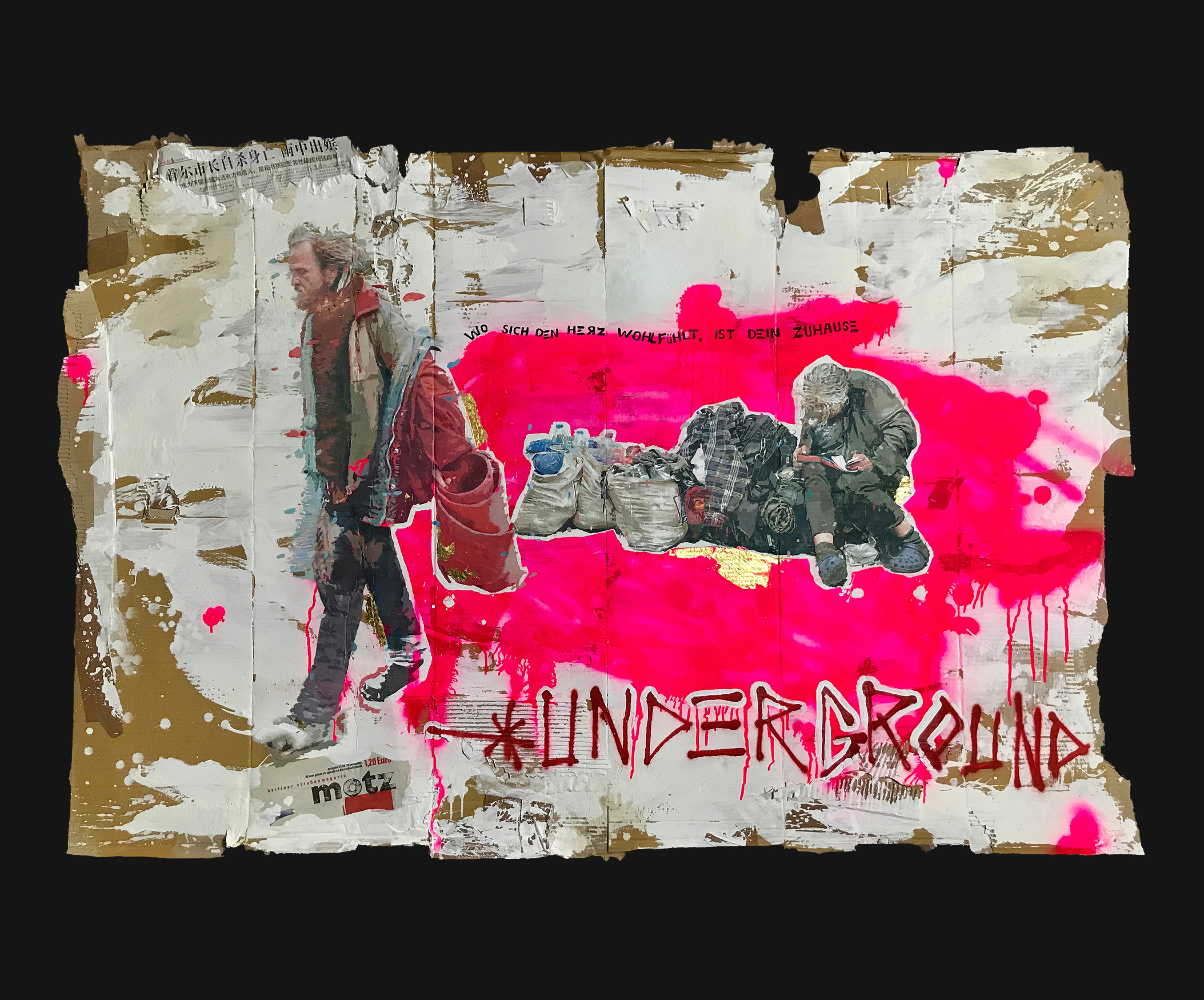
Paradise City
“Paradise City” © 2020 (english)
Acrylic, Oil, Spray and Blattgold 24 Karat on Cardboard. Framed with glass. Different measures.
It is already known: In Japan, gold is a special metal with the task of repairing broken objects. The repaired defect is a unique piece of the object’s life that adds to its beauty.
Repair is an action that does not belong to all of us, but in this way to repair instead of throwing it in the trash corresponds to a special way of treating injuries and with a single and beautiful intention: to be able to prolong life.
Beauty corresponds to art, the ability of a real artist depends on his creativity to bring this concept, beauty, to his art work.
Since the origins of mankind, ugliness and beauty have both been an established measure in our society, and artists in particular are still the professionals to exchange them with one another. The ability to illuminate the darkness, contribute life to death, these types of talents only correspond to the artist and his creativity, in a constellation of communication, based on a unique and special language: the subjective language.
The combination of stunted materials, worthless, such as cardboard, or newspaper clippings, adhesive tape for packaging, are not the usual and academic materials that a normal artist can dream of to develop a masterpiece, even a moral question can be asked when the combination looks for the previously mentioned beauty through gold leaf on the cardboard, not only that, also a figurative representation of the reality of our society through a quasi believable personages painted from oil.
Combination of languages, urban art, literary reminiscences, irony and representational craft for your own creativity are the ingredients of this series, a tough portrait of the current capitals of our time, both the old EU, as well as Berlin, Madrid, Barcelona, Rome, Paris, as well as USA, New York, Chicago, maybe Philadelphia…? Blind urban landscapes for everyone who wants to see the reality of our day to day in a different direction. But they are there.
The difficulty of a picture is due to its narrative power, you can read and imagine, the task of a painter is reversed: the challenge to tell a lot through the picture, to add to, to describe and of course to get a reaction from the audience through this communication. Not easy work.
Difficult times, pandemics, biological wars, the future is already here, but nothing has changed at all, gold on cardboard, glow from the darkness … Exactly the task of an artist should only be there, as today’s journalist, just to to describe a contemporary society.
In the digital age where the differences between these crisis-pandemic-generations and people in general have peaked, a large part of this society still needs a golden filter to take them into account or maybe the gold plays a role in repairing our mistakes.
Isn’t cruelty a constant in our history?
Emilio Fornieles
Text for “Paradise City” series © 2020
“Paradise City” © 2020 (Deutsch)
Es ist bereits bekannt: In Japan ist Gold ein besonderes Metall, mit der Aufgabe gebrochene Objekte zu reparieren. Der reparierte Makel ist ein einzigartiger Teil des Lebens des Objekts, welches zu seiner Schönheit beiträgt.
Die Reparatur ist eine Technik, die nicht zu jedem von uns passt, jedoch ist es eine Möglichkeit die Objekte, statt sie in den Müll zu werfen, wie mit einer Verletzung zu behandeln. Dabei gibt es eine einzige und wundervolle Absicht: die Lebensdauer zu verlängern.
Schönheit entspricht der Kunst: die Fähigkeit eines echten Künstlers hängt von seiner Kreativität ab, mit welcher er das Konzept der Schönheit in seine Kunstwerke einfließen lässt. Seit Anbeginn der Menschheit sind sowohl Hässlichkeit als auch Schönheit etablierte Maßstäbe in unserer Gesellschaft. Besonders Künstler sind bis heute Experten, sie untereinander auszutauschen. Die Fähigkeit Licht ins Dunkle zu bringen oder mit dem Leben zum Tod beizutragen – diese Art von Talenten entsprechen nur denen eines Künstler und seiner Kreativität. Dabei greift er auf eine Form der Kommunikation zurück, die auf einer eigenen und besonderen Sprache basiert: die subjektive Sprache.
Die Kombination aus verkümmerten Materialen, so wertlos wie Pappe oder Zeitungsausschnitte, mit Klebeband sind nicht die üblichen und akademischen Methoden, von denen ein Künstler normalerweise für die Verwirklichung seines Meisterwerks träumt. Es kann sogar nach der Moral gefragt werden, wenn die Kombination von Blattgold und Pappe nach der besagten Schönheit strebt. Die in Öl gemalten Personen repräsentieren dabei die Realität unserer Gesellschaft.
Sprachen, Urban Art, literarische Erinnerungen, Ironie und die Repräsentation der eigenen Kreativität – das sind die Inhalte dieser Serie. Sie zeigt die harten Portraits der Großstädte unserer Zeit wie Berlin, Madrid, Barcelona, Rom, Paris, der neuen und alten EU, aber auch die der USA wie New York, Chicago und Philadelphia! Blinde, urbane Landschaften für alle, die die Realität unseres Alltags in neuem Licht sehen wollen. Hier sind sie.
Die Herausforderung, die ein Bild birgt, hängt von seiner narrativen Intensität ab. Der Betrachter liest, schaut und stellt sich vor, doch die Aufgabe des Malers ist genau umgekehrt: Vieles mit dem Bild zu erzählen, etwas beizutragen oder beschreiben, und vor Allem dem Publikum eine Reaktion durch diese Art von Kommunikation zu entlocken. Keine leichte Arbeit.
In schwierigen Zeiten von Pandemien bis zu biologischen Kriegen- die Zukunft ist bereits hier. Jedoch hat sich nichts verändert, Gold auf Pappe, Leuchten aus der Dunkelheit… die Aufgabe eines Künstlers sollte die gleiche sein wie die eines Journalisten: die zeitgenössische Gesellschaft beschreiben.
Im digitalen Zeitalter, in welchem die Unterschiede dieser Krisen-Pandemie-Generation und Menschen im Allgemeinen die Spitze erreicht haben, benötigt ein großer Teil der Gesellschaft noch immer einen goldenen Filter um konfrontiert zu werden. Oder spielt das Gold eine Rolle bei der Wiedergutmachung unserer Fehler?
Ist Grausamkeit denn nicht schon immer eine Konstante in unserer Geschichte gewesen?
Emilio Fornieles
Text der Serie “Paradise City” © 2020
Paradise City
(traducción al Castellano)
„Ya se sabe: en Japón, el oro es un metal especial con la tarea de reparar objetos rotos.
El defecto reparado es una pieza única de la vida del objeto que se suma a su belleza.
Reparar es una acción que no nos pertenece a todos, pero de esta manera reparar en lugar de tirarla a la basura corresponde a una forma especial de tratar las lesiones y con una única y hermosa intención: poder prolongar la vida.
La belleza corresponde al arte, la capacidad de un artista real depende de su creatividad para llevar este concepto, la belleza, a su obra de arte.
Desde los orígenes de la humanidad, la fealdad y la belleza han sido una medida establecida en nuestra sociedad, y los artistas en particular siguen siendo los profesionales para intercambiarlos entre sí.
La capacidad de iluminar la oscuridad, aportar vida a la muerte, este tipo de talentos solo corresponden al artista y su creatividad, en una constelación de comunicación, basada en un lenguaje único y especial: el lenguaje subjetivo.
La combinación de materiales atrofiados, sin valor, como cartón, o recortes de periódicos, cinta adhesiva para embalajes, no son los materiales habituales y académicos con los que un artista normal puede soñar para desarrollar una obra maestra, incluso se puede plantear una pregunta moral cuando la combinación busca la belleza antes mencionada a través del pan de oro sobre el cartón, no solo eso, también una representación figurativa de la realidad de nuestra sociedad a través de unos personajes casi creíbles pintados al óleo.
Combinación de lenguajes, arte urbano, reminiscencias literarias, ironía y artesanía representativa para la propia creatividad son los ingredientes de esta serie, un duro retrato de las capitales actuales de nuestro tiempo, tanto en la antigua UE, como Berlín, Madrid, Barcelona, Roma, París, así como en Estados Unidos, Nueva York, Chicago, ¿quizás Filadelfia…? Paisajes urbanos ciegos para todo aquel que quiera ver la realidad de nuestro día a día en una dirección diferente. Pero están ahí.
La dificultad de un cuadro se debe a su poder narrativo, se puede leer e imaginar, la tarea de un pintor se invierte: el desafío de contar mucho a través del cuadro, de agregar, de describir y por supuesto de obtener una reacción de la audiencia a través de esta comunicación. No es un trabajo fácil.
Tiempos difíciles, pandemias, guerras biológicas, el futuro ya está aquí, pero nada ha cambiado, oro sobre cartón, resplandor de la oscuridad … Exactamente la tarea de un artista solo debe estar ahí, como el periodista de hoy, solo para describir un sociedad contemporánea.
En la era digital donde las diferencias entre estas generaciones de crisis-pandemias y las personas en general han tocado techo, una gran parte de esta sociedad todavía necesita un filtro dorado para tenerlas en cuenta o tal vez el oro juega un papel en la reparación de nuestros errores.
¿No es la crueldad una constante en nuestra historia?“
Emilio Fornieles
Texto de la Serie “Paradise City” © 2020
